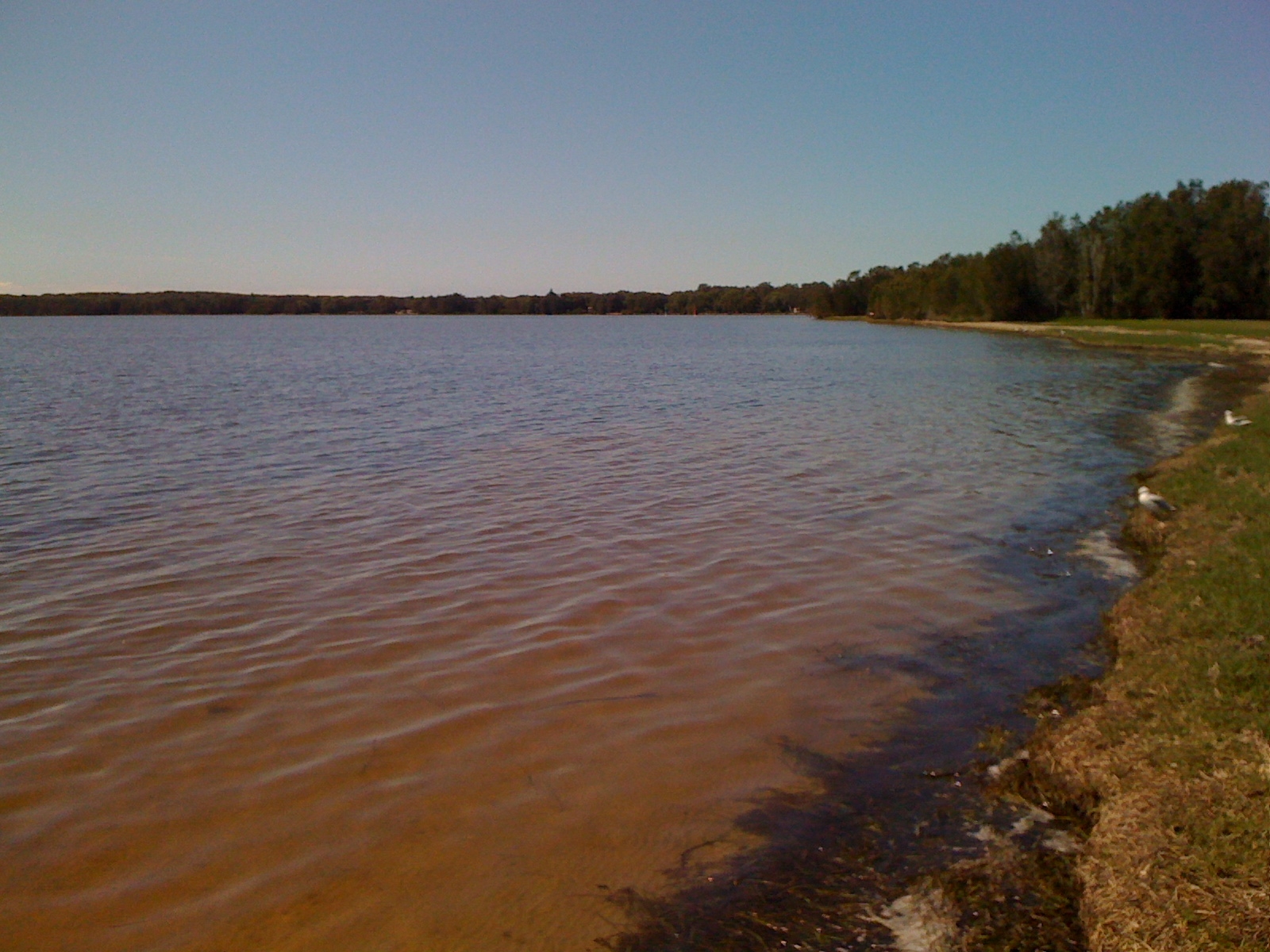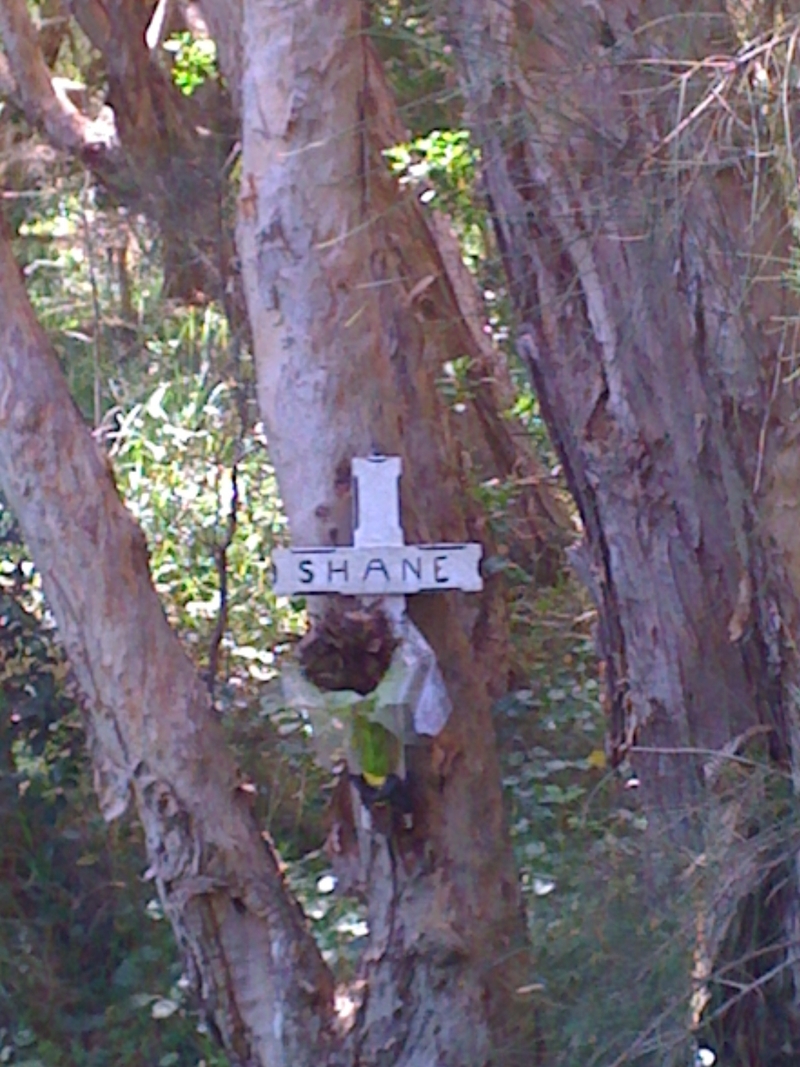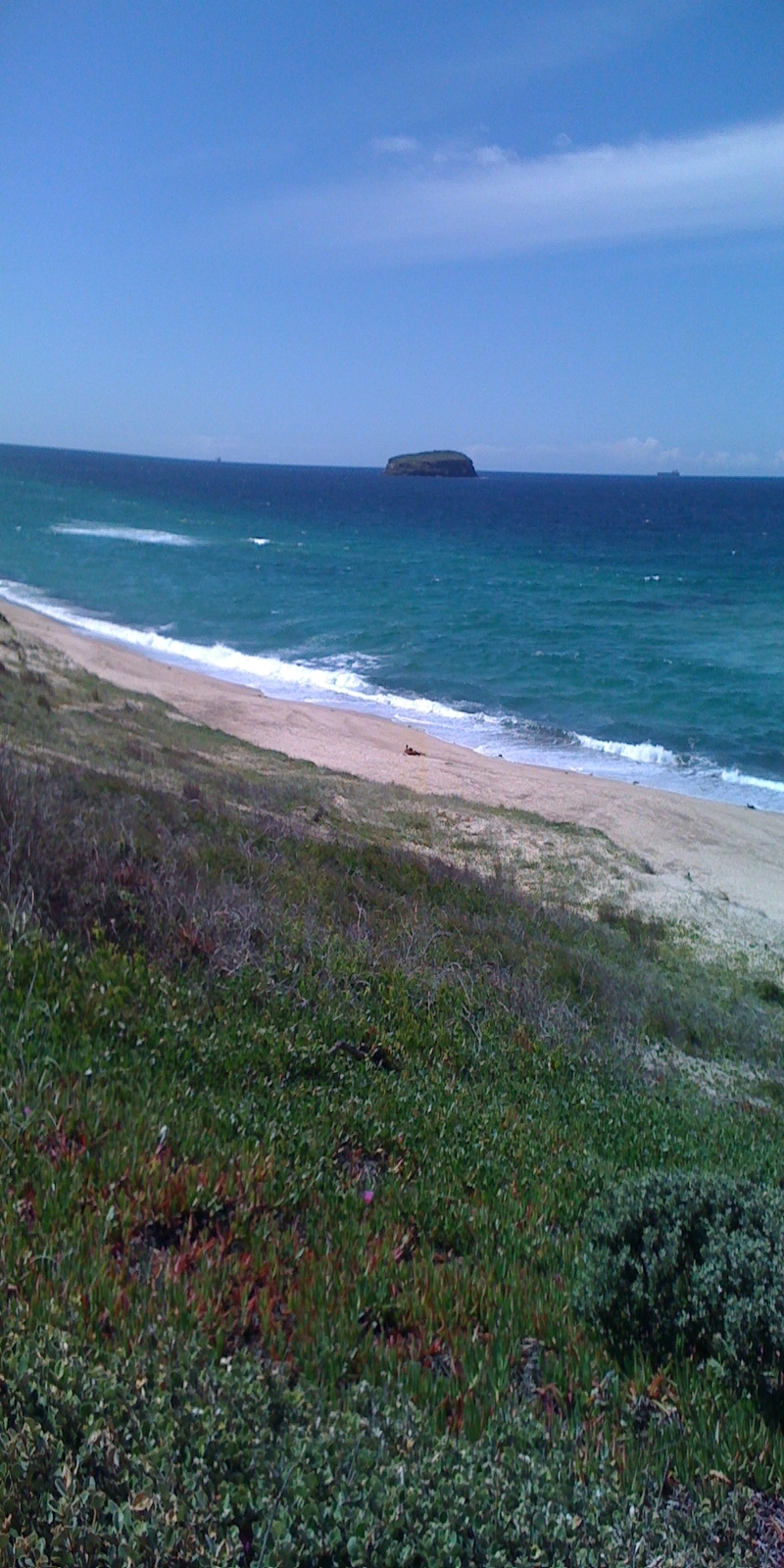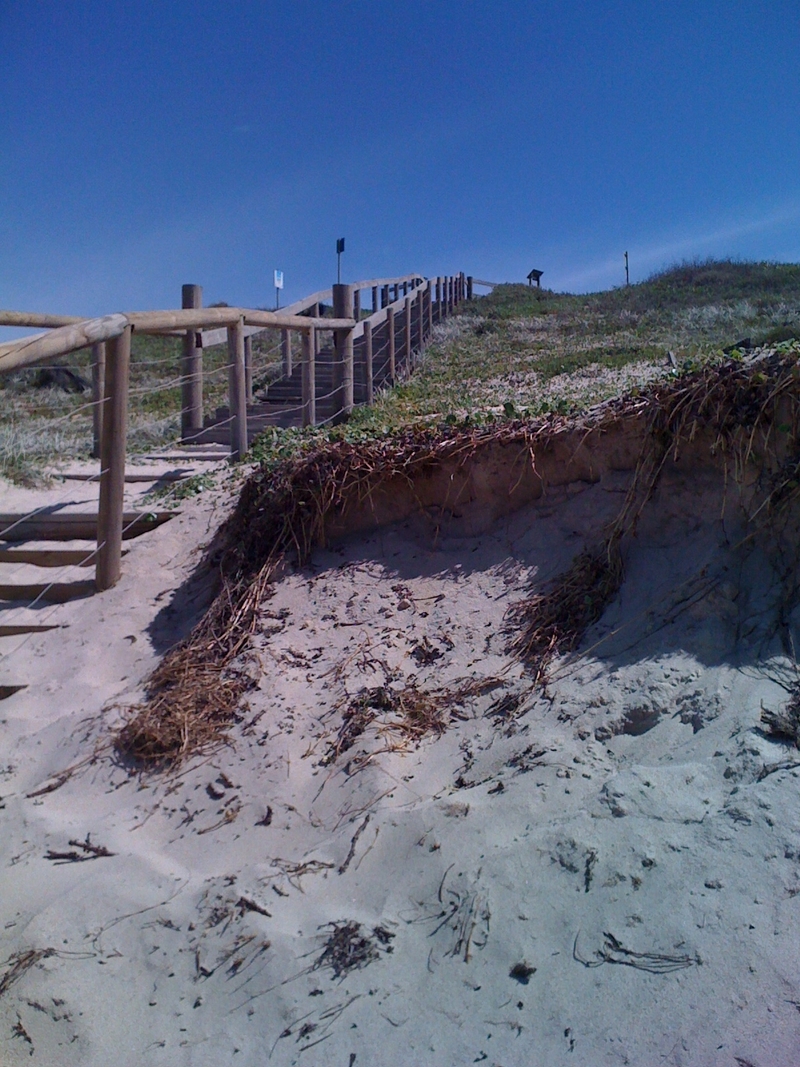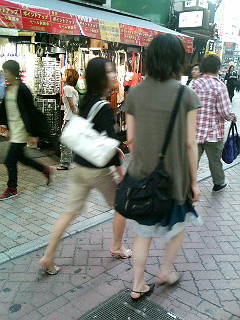 One of the first places I visited in Japan was Shibuya (渋谷), the jubilant youth fashion quarter south of Shinjuku, on the prosperous west side of Tokyo. The date was November 11 2000, my first ever morning in Japan! The sun was shining, the crows were cawing: it was textbook Tokyo to a treat. Unfortunately, my baggage had been lost in transit, and was sitting on a carousel at the airport in Singapore. I was dressed only in my Australian jeans and a T-shirt, and the cold Japanese winter was coming on. I needed to buy a winter coat -- and cheaply! Fortunately, Shibuya saved me. That's the great thing about it, it is a Mecca for recycled clothing. I never expected it would be like this, until I took my first stroll through the narrow winding streets here, looking for a place to stay. I thought Japanese hated old stuff, and were obsessed with the shiny and new. Certainly, the architecture accumulated around Shibuya's sprawling railway station seemed futuristic to a fault, that morning in November 2000: towering department stores, some adorned with colossal TV screens or posters of J-Pop stars, and ads for the latest Beatles anthology. That was the kind of Japan I was expecting and it was all there, in overload. Brand name department stores and bling, check. Fast, brightly colorful passenger trains whizzing by overhead, you bet. Hypermanic salespeople spruiking the crowds with their megaphones and cupped hands, sure. But second hand clothes stores? Who would have thought that? There were tonnes of them, especially on the road which links Shibuya to Yoyogi Park, which I trudged up looking for lodgings. I couldn't find anywhere to stay, but I shortly discovered a preloved jacket, in a bitching industrial style!
One of the first places I visited in Japan was Shibuya (渋谷), the jubilant youth fashion quarter south of Shinjuku, on the prosperous west side of Tokyo. The date was November 11 2000, my first ever morning in Japan! The sun was shining, the crows were cawing: it was textbook Tokyo to a treat. Unfortunately, my baggage had been lost in transit, and was sitting on a carousel at the airport in Singapore. I was dressed only in my Australian jeans and a T-shirt, and the cold Japanese winter was coming on. I needed to buy a winter coat -- and cheaply! Fortunately, Shibuya saved me. That's the great thing about it, it is a Mecca for recycled clothing. I never expected it would be like this, until I took my first stroll through the narrow winding streets here, looking for a place to stay. I thought Japanese hated old stuff, and were obsessed with the shiny and new. Certainly, the architecture accumulated around Shibuya's sprawling railway station seemed futuristic to a fault, that morning in November 2000: towering department stores, some adorned with colossal TV screens or posters of J-Pop stars, and ads for the latest Beatles anthology. That was the kind of Japan I was expecting and it was all there, in overload. Brand name department stores and bling, check. Fast, brightly colorful passenger trains whizzing by overhead, you bet. Hypermanic salespeople spruiking the crowds with their megaphones and cupped hands, sure. But second hand clothes stores? Who would have thought that? There were tonnes of them, especially on the road which links Shibuya to Yoyogi Park, which I trudged up looking for lodgings. I couldn't find anywhere to stay, but I shortly discovered a preloved jacket, in a bitching industrial style!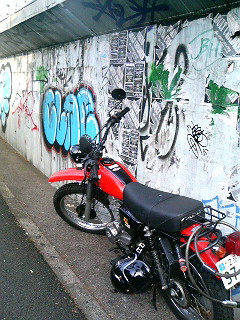 According to the must see website: "Shibuya leads Japan in popularity, constantly creating new culture in the worlds of fashion, food, and music. Fashion trends that start here always draw the attention of young people and they quickly spread throughout Tokyo and then the rest of the country. Sometime between the late 80's and early 90's, Shibuya started to attract public attention as a fashion town. Shibuya, subsequently became more entrenched as the definitive spot for Tokyo's youth. With the boom in brand awareness and the economic boost of the Bubble Economy, PARCO and Marui enjoyed several prosperous years in that era. After Shibuya reached its peak as a trend-setting neighborhood, the town quickly fell back during the economic strife of the late 90's. Though the unusual fashion and makeup among teenage girls captured public attention again during the late 90's, it was in vogue for a very short time."
According to the must see website: "Shibuya leads Japan in popularity, constantly creating new culture in the worlds of fashion, food, and music. Fashion trends that start here always draw the attention of young people and they quickly spread throughout Tokyo and then the rest of the country. Sometime between the late 80's and early 90's, Shibuya started to attract public attention as a fashion town. Shibuya, subsequently became more entrenched as the definitive spot for Tokyo's youth. With the boom in brand awareness and the economic boost of the Bubble Economy, PARCO and Marui enjoyed several prosperous years in that era. After Shibuya reached its peak as a trend-setting neighborhood, the town quickly fell back during the economic strife of the late 90's. Though the unusual fashion and makeup among teenage girls captured public attention again during the late 90's, it was in vogue for a very short time."However, while the economy has slumped, recycled fashions have risen to a new prominence. When funds run low, you turn to budget alternatives. And I believe this is one reason why Japan today is caught in a recycled clothing epidemic. Japan is turning to cheaper alternatives -- this is a good thing, a vagabondist thing. To me, nothing seems so vagabondist as the recycling of clothes and other essential items. It is the ultimate in vagabondism, and Japan is now patently a vagabondist country -- I realised that as soon as I stepped off the plane. I was expecting it to be a Bubble economy, but thankfully it turned out to be postBubble. It was (and still is) a glimpse of life after the Baudrillardian implosion, for those Westerners saddled with their fantasies of endless growth. Young people in Japan understand that while the conveyor belts of production are now dragging to a halt, there are nonetheless vast mountains of goods lying around all over the world, some of them in their original wrappers, waiting to be (un/dis)covered. Just don't call these gems "second hand", or even recycled... they're vintage! Japanese might be budget conscious, but they still have class. Even when they're grungy, Japanese are styling!
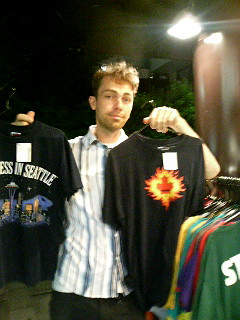
For the next 10 years, I used to go shopping in Shibuya a lot. Eventually I got sick of it, and started looking for fresh pastures, out in the suburbs where tourists rarely tread. When foreign friends and relatives came to visit, however, they always insisted on meeting in Shibuya, and seeing that globally renowned Tokyo street style. I made sure to show them some of the recycled clothes stores in the neighborhood too, and my guests were always impressed.
There are flea markets in the Shibuya as well, especially around Yoyogi Park (opposite the NHK headquarters) on weekends, and they are usually popular. The International Herald Tribune reports:
There are two choices when it comes to buying used clothes in Tokyo: flea markets or clothing shops. Make that three choices if you count the street stalls that crop up on sunny days.
A visit to the Sunday flea market on the roof of the Tokyu Store, across from the East Exit of Shibuya Station, gives a glimpse into the future of clothes recycling in Japan. Most of the buyers and sellers are school kids in their early teens, who pour out of the rooftop elevator at 10 A.M. lugging big sacks of clothes to sell to each other. The limited roof space fills up quickly with shoppers sifting through clothes, shoes, a few electronic goods and the occasional box of used CDs or tapes.
By 11 A.M. the place is crammed, but you can usually decide whether a vendor's clothes are worth working your way toward by looking at what he or she is wearing. If the vendor goes for the massive-street-pants-and-oversized-shirt look, and you don't, try another direction.
Prices vary, but they tend to be low. Jeans that sell for 7,000 yen ($84) or more at the established Shibuya department stores can be found in nearly the same condition for 1,000 yen or less. T-shirts are another popular item that can be bought for around 500 yen. Point out imaginary flaws and demand a discount if you want: Bargaining is considered all part of the fun.That's an insight into flea markets, but what about the vintage stores? Here is a snapshot of what existed in Shibuya in the mid 2000s (sorry if some of this information is a bit old!):
Cat Street, 6-14-7 Jingumae, Shibuya Ward, Tokyo.
Phone: (03) 5464 5580.
This story was lifted from Tokyo's well known and even more well read Metropolis magazine:
The craze for vintage clothing has been hitting some fashion retailers pretty hard, especially those whose business is street casual wear. Few brands are as prized as adidas when it comes to vintage, and the guys at head office have come up with a scheme to cash in on the cachet of the company's illustrious history: adidas Originals. Opened on Cat Street last month, the store is laid out much like a flea market with low trestle tables and haphazard stacks of cardboard boxes. The stock consists chiefly of remakes of classic adidas items from 1972-1996, allowing shoppers to get the retro look without having to traipse around swap meets or trawl through vintage stores. You may need to wear in the 83-C training top and 1976 Stan Smiths yourself, but at least the smells and stains will be your own. Some newly designed items on offer include the affordable Levi's collaboration denim sneakers and not-so-affordable Swarovski collaboration, a rhinestone-encrusted fantasy shoe available only in this store.The shack is open from 11am-8pm daily.
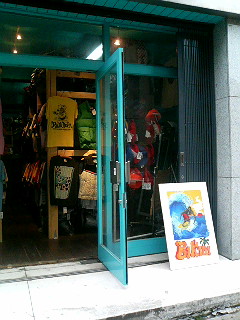 Bikini Surfboard: 渋谷区神宮前.
Bikini Surfboard: 渋谷区神宮前.Jingumae, Shibuya Ward, Tokyo.
Phone: (03) 3409-5017.
On the way to the Olympic Stadium and Yoyogi Park, if you are heading from Shibuya. Despite what the name implies, they don't sell surfboards here, but rather recycled surfwear like T-shirts and sh!t. Billabong and the House of Town & Country and all that jazz. I didn't see any bikinis inside either, so don't go looking for them. Placing your trust in Japanese-English names and signs will always disappoint you. I can almost imagine when the guys who opened this store were trying to think of a name, they decided just to slam together all the surf-related English words that they knew. "What surf words do we know? -- bikini... surfboard... hey, let's call the shop Bikini Surfboard!" It would be like if a bunch of Californian guys who spoke no Japanese decided to open a sushi restaurant -- what would they call it? "Sayonara Samurai" or something like that? Or maybe just "Sayonara Sucker"!
There are of course surf-inspired and Hawaiian stores all over Japan, but this one has a strictly recycled and vintage theme.
Open 11am to 8pm.
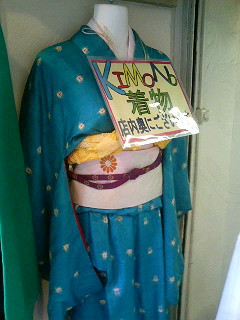 Chicago: 渋谷区神宮前6-31-21.
Chicago: 渋谷区神宮前6-31-21.6-31-21 Jingumae, Shibuya Ward, Tokyo.
Phone: (03) 3409 5017. Web: http://www.chicago.co.jp/.
Variety of vintage goods here: T-shirts, training gear, jeans, hats, coats, kimono, haori, modern clothing made from kimono, much more. Has several stores, mostly in Tokyo. At the Harajuku branch, you can even buy a used kimono!
The complete store list is as follows:
Omotesando Store/Tokyo: 6-31-21 Jingumae Shibuya Tokyo. Phone (03) 3409 5017.
Jingumae Store/Tokyo: 4-26-26 Jingumae Shibuya Tokyo. Phone (03) 5414 5107.
Shimokitazawa Store/Tokyo: 5-32-5 Daizawa Setagaya Tokyo. Phone (03) 3419 2890.
Sapporo Store: 1-3 Nishi Minami 1 Jyou Chuou Sapporo Hokkaido. Phone (011) 219 2202.
Fukuoka Store: 1-15-35 Daimyo Chuou Fukuoka. Phone (092) 739 0165.
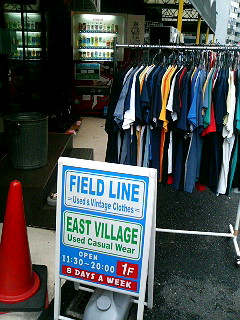 East Village/Field Line: 渋谷区神宮前6-19-16第3宇都宮ビル1F .
East Village/Field Line: 渋谷区神宮前6-19-16第3宇都宮ビル1F .1st Floor Number 3 Utsunomiya Building, 6-19-16 Jingumae, Shibuya Ward, Tokyo.
Phone: (03) 3486 6716.
低価格、豊富な品揃え、高品質の古着を展開するイースト ヴィレッジ。アメカジ古着を中心としたラインナップは、ストリートの中でハズせないものばかり。ウェアだけでなく、ブーツなどフットウェアから、小物まで幅広く取り扱っている。ヴィンテージを中心とした姉妹店フィールドラインも併設おり、ともにタウンスポットが経営している。
Last time I waltzed past there was a rack of shirts out the front selling for just 100 Yen... but maybe that was because it was an end of summer sale.
Up the road from East Village you can find Mesa, another select used clothing, which boasts badges... tonnes of them. Also plenty of shoes and French hip-hop stuff on the soundsystem, ultracool Japanese staff.
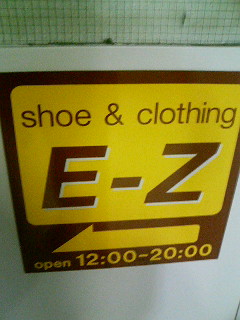 E-Z shoe & clothing: 渋谷区神宮前1-12-16和光ビル2AF.
E-Z shoe & clothing: 渋谷区神宮前1-12-16和光ビル2AF.2A Floor Wakkou Building, Jingumae, Shibuya Ward.
Phone: (03) 3780 0494.
A small, non-descript shop on the second floor of a building on the big road linking Shibuya and Harajuku, E-Z is packed with West Coast, recycled clothes -- basketball shirts and faded jeans, etc. To be honest this is one of my fave haunts in the Jinguumae area, and it is situated not far from Tower Records, one of the regional landmarks. Plenty of dead stock shoes with an Adidas look, including live actual Adidases. There are rare trainers from countries that don’t even exist any more, such as Yugoslavia and West Germany. Expect to pay between 20,000 Yen and 100,000 Yen for a pair of shoes. Clothes much cheaper... say 2000 Yen to 10,000 Yen for Levis from the 70s or a Tshirt of Bert & Ernie, or something from the Hawaian school of thought.
E-Z shoe & clothing is open from 12noon to 8pm daily.
Located in the basement floor of the same building is Tom’s Shop Usa 古着, which is described later in this article.
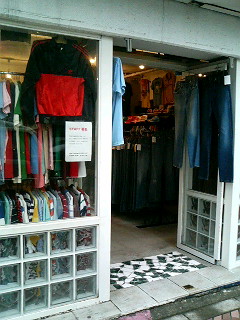 Flamingo Saloon: 渋谷区神南.
Flamingo Saloon: 渋谷区神南.Jingumae, Shibuya Ward, Tokyo.
There is no sign on this store and the last time I visited, only a small piece of paper stuck to the door acknowledged its name: Flamingo Saloon. Then again, it might be called Pink Flamingo,I am not quite sure. At the very least there are two stores connected to each other (same owner perhaps, part of a chain) -- Pink Flamingo and Flamingo Saloon -- and you can find one of them in Shibuya, along the road at Jinguumae from Shibuya to Harajuku. This is basically another Shibuya style vintage clothes store with a street front. Phone is (03) 3477 7376 for the Flamingo Saloon and (03) 5489 4440 for the Pink Flamingo.
By the way, if you are interested in the world of Japanese city fashion, you should click this link -- it's an online Japanese fashion magazine, and it contains a list of clothes stores in Tokyo. They have an article inside called People Like A Used Clothing, with a model shot on location in such picturesque locations as Yoyogi Park.
 John's Clothing: 渋谷区神南1-11-5 ダイネス壱番館1F.
John's Clothing: 渋谷区神南1-11-5 ダイネス壱番館1F.1st Floor Dainesu Ichiban Jinankan, 1-11-5 Shibuya Ward, Tokyo.
Phone: (03) 3464 7705.
In the same building as another classic clothes store celebrating the spirit of California, Santa Monica, and adjacent to the wellknown guitar shop, Acoustic Design. This looks like a funky little number, but it is one of only many recycled/classic clothes stores in this part of town. Why do they call it John's Clothing? I am sure that this being Japan, the owner's name is probably something like Hiroshi or Koji or something like that. Anything but John. Perhaps they called this shop "John's Clothing" because John is the stereotypical name of the Westerner -- the Anglo-American-Australian who would normally be wearing these kinds of clothes. Nonetheless, the shop is cool, so you better check it out.
More Budget ESP: 東京都渋谷区神南1-9-2Oビル1F.
1st floor 0 Building, 1-9-2 Jinnan, Shibuya Ward, Tokyo.
Phone: (03) 3461 5055.
 You can find a lot of neat stuff in Shibuya... there is a whole hilly hiphop district and a big mall devoted solely to Harley Davidson apparel. The classic clothes district of Shibuya is not half as glamorous as the hiphop district, but perhaps that is in keeping with the laidback attitudes of the genre. In the middle of the district I found a store called More Budget ESP -- whether it is still there with the same name when you visit is an open question. Interestingly, More Budget is not really a classic clothes shop at all... but rather a hiphop/reggae influenced boutique. If like me you like reggae you will also like this shop. There are plenty of fliers on display giving you a good introduction to the Japanese reggae scene. For example I picked up a leaflet advertising a Reggae Dancehall night called Rocker's Paradise at Shibuya Club Camelot (every 2nd Wednesday ++ next show on 07/02/14 featuring Burn Down from Osaka, Super-G and Gladiator with sound system + 2500 Yen plus ID to get in the door.) Apart from Shibuya Club Camelot, the long running Club Asia is another good place to catch reggae and hiphop events. Also check out Club Unity. If you need to buy reggae records in Shibuya, go to Homebass Records, duel, or Rocker's Island.
You can find a lot of neat stuff in Shibuya... there is a whole hilly hiphop district and a big mall devoted solely to Harley Davidson apparel. The classic clothes district of Shibuya is not half as glamorous as the hiphop district, but perhaps that is in keeping with the laidback attitudes of the genre. In the middle of the district I found a store called More Budget ESP -- whether it is still there with the same name when you visit is an open question. Interestingly, More Budget is not really a classic clothes shop at all... but rather a hiphop/reggae influenced boutique. If like me you like reggae you will also like this shop. There are plenty of fliers on display giving you a good introduction to the Japanese reggae scene. For example I picked up a leaflet advertising a Reggae Dancehall night called Rocker's Paradise at Shibuya Club Camelot (every 2nd Wednesday ++ next show on 07/02/14 featuring Burn Down from Osaka, Super-G and Gladiator with sound system + 2500 Yen plus ID to get in the door.) Apart from Shibuya Club Camelot, the long running Club Asia is another good place to catch reggae and hiphop events. Also check out Club Unity. If you need to buy reggae records in Shibuya, go to Homebass Records, duel, or Rocker's Island.Puma: 渋谷区神南1-13-4.
1st floor Harajuku Quest Building, 1-13-4 Jingumae, Shibuya Ward, Tokyo.
Phone: (03) 3401 6100.
Another Metropolis sample follows here:
Bitter rivals of adidas for 54 years, having been established by Adolf Dassler's disgruntled brother Rudi, Puma is still battling it out with the three stripes for dominance of the retro sneaker market. Puma's latest move in the war is the unveiling of the world's second Puma concept store (the first is in Santa Monica, Calif.) late last year in Harajuku. As might be expected from a concept store, this one boasts a smart, clean interior and is sparsely stocked with high-end Puma products. The Italian-designed revival line, Platinum Collection, is the mainstay of this sneaker freak's paradise, but specially selected accessories, bags and clothes from other lines do make their way into the store. If you need to get kitted out for the gym, get down to Kanda, where "concept" means high-brow, high-fashion, high prices. Those who care about what message their footwear communicates won't want to miss the hot releases due in store this season. With the resounding success of the Puma/Sparco boxing boots behind them, more dual name sneakers are in the cards, including a new Jil Sander design. This store is the only place to be seen buying that dinky gym bag, a styling T-shirt or a good ol' pair of Clydes.
The joint is open from 11am to 8pm.
Ray Beams Remodeled: 渋谷区神宮前3-24-7.
3-24-7 Jingumae, Shibuya Ward, Tokyo.
Phone: (03) 3478 5886.
According to the once informative, international (and now, sadly, defunct) w-guides site, Ray Beams Remodeled "stocks customized secondhand and old clothing. However, unlike many other "recycle" stores, Ray Beams attempts to keep the loud "hippie" chic style away from its products. Instead, simple more neutral designs are made up from a mixture of old and new materials. The result is a more casual and comfortable range of clothing. The knitwear is particularly good and there are still some more eccentric items in the form of hand-painted and sequined T-shirts. There will soon be a range of imported recycle products from LA." The nearest train stops at Meijijingumae Station, and the shop is open from 11am-8pm daily.
Santa Monica: 渋谷区神南1-11-5.
1-11-5 Jinnan, Shibuya Ward, Tokyo -- a few doors down from Tower Records, that monstrous yellow landmark.
Phone: (03) 3409 5017.
I read this somewhere: アメリカ全土から買い付けされたアイテムが不定期に入荷。サンタモニカの姉妹店の中でもレギュラーアイテムを中心に着こなしとり入れやすいアイテムが揃う。今シーズンはボア付きのGジャンやコーテュロイアイテムがおすすめ。
Shop 33: 渋谷区神宮前1-12-16和光ビル2AF.
2A Floor Wakkou Building, Jingumae, Shibuya Ward.
Phone: (03) 3780 0494.
The Harajuku store for this chain is at 5-18-8 Jingumae, Shibuya-ku (phone: (03) 5468 3133). The Kichijouji store for those out further west is in the Keyaki Building 3F 1-1-8 Minami-Chou, Kichijouji, Musashino-shi (phone: (0422) 487 926).
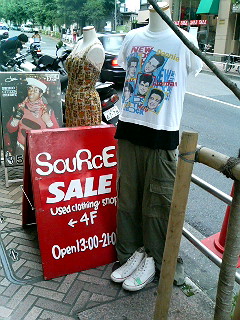
Source: 渋谷区神宮前渋谷区サンフォレスト森田ビル4F.
4th floor San Forest Building, Jingumae, Shibuya Ward, Tokyo.
It is a steamy Sunday afternoon in August, and the streets of Shibuya are jammed with the usual packs of misfits. I stopped at a used clothes shop called Source. It is at the far end of Shibuya (actually Jingumae) near Shibuya Fire Station. In the Sun Forest Morita Building, on the 4th floor. There is the usual array of classic items for guys and girls... about 5000 yen for most stuff. It seems more girl friendly than other shops discussed on this page. On the other hand, there is nothing in this shop special or outstanding enough to justify climbing those four flights of stairs up there (there is a lift, but still, you have to stand around waiting for it to come), and the place is so small, you could probably skip it. In this part of town there is a used clothes store every 20 metres or so, so move on folks and find a better shop!
As the sign says, open from 1pm to 9pm.
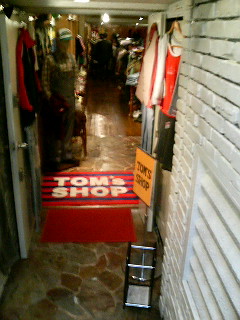 Tom's Shop: 渋谷区神宮前1-12-16和光ビルBF.
Tom's Shop: 渋谷区神宮前1-12-16和光ビルBF.Basement floor Wakkou Building, Jinguumae, Shibuya Ward.
Phone: (03) 5456 0236.
This place used to be on the 5th floor of the 和光 building, but as of late March 2006, could be found on the more accessible basement floor. It is similar to the E-Z shoes & clothes outlet up on the 2nd floor, although the shoes are cheaper (under 5000 Yen as far as I could see.) Apart from that, there is the usual selection of vintage wear, at pretty good prices.
Open 12noon to 9pm. Across the road from ABC Mart.
We Go: 渋谷区神宮前6-5-3ビル1-2F.
Iberia Biru 1F & 2F, 6-5-3 Jingumae, Shibuya, Tokyo.
Phone: (03) 3400 7625.
Variety vintage. T-shirts, jeans, shirts, hats, coats, you name it. Large chain with stores all over Japan. Open 10am to 9pm.





